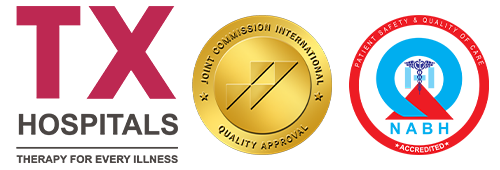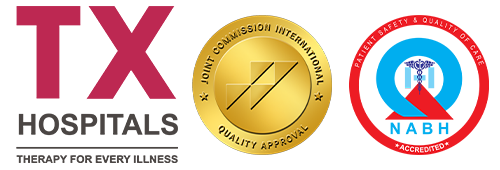Lung cancer
Lung cancer is a disease caused by uncontrolled cell division in your lungs. Your cells divide and make more copies of themselves as a part of their normal function. But sometimes, they get changes (mutations) that cause them to keep making more of themselves when they shouldn’t. Damaged cells dividing uncontrollably create masses, or tumors, of tissue that eventually keep your organs from working properly. Lung cancer is the name for cancers that start in your lungs — usually in the airways (bronchi or bronchioles) or small air sacs (alveoli). Cancers that start in other places and move to your lungs are usually named for where they start (your healthcare provider may refer to this as cancer that’s metastatic to your lungs).

Types of lung cancer
There are many cancers that affect the lungs, but we usually use the term “lung cancer” for two main kinds: non-small cell lung cancer and small cell lung cancer.
Non-small cell lung cancer (NSCLC)
Non-small cell lung cancer (NSCLC) is the most common type of lung cancer. It accounts for over 80% of lung cancer cases. Common types include adenocarcinoma and squamous cell carcinoma. Adenosquamous carcinoma and sarcomatoid carcinoma are two less common types of NSCLC.
Small cell lung cancer (SCLC)
Small cell lung cancer (SCLC) grows more quickly and is harder to treat than NSCLC. It’s often found as a relatively small lung tumor that’s already spread to other parts of your body. Specific types of SCLC include small cell carcinoma (also called oat cell carcinoma) and combined small cell carcinoma.
Other types of cancer in the lungs
Other types of cancer can start in or around your lungs, including lymphomas (cancer in your lymph nodes), sarcomas (cancer in your bones or soft tissue) and pleural mesothelioma (cancer in the lining of your lungs). These are treated differently and usually aren’t referred to as lung cancer.
Stages of Lung cancer
Each stage has several combinations of size and spread that can fall into that category. For instance, the primary tumor in a Stage III cancer could be smaller than in a Stage II cancer, but other factors put it at a more advanced stage. The general staging for lung cancer is:
Stage 0 (in-situ): Cancer is in the top lining of the lung or bronchus. It hasn’t spread to other parts of the lung or outside of the lung.
Stage I: Cancer hasn’t spread outside the lung.
Stage II: Cancer is larger than Stage I, has spread to lymph nodes inside the lung, or there’s more than one tumor in the same lobe of the lung.
Stage III: Cancer is larger than Stage II, has spread to nearby lymph nodes or structures or there’s more than one tumor in a different lobe of the same lung.
Stage IV: Cancer has spread to the other lung, the fluid around the lung, the fluid around the heart or distant organs.
Symptoms of lung cancer
Most lung cancer symptoms look similar to other, less serious illnesses. Many people don’t have symptoms until the disease is advanced, but some people have symptoms in the early stages. For those who do experience symptoms, it may only be one or a few of these:
A cough that doesn’t go away or gets worse over time.
Trouble breathing or shortness of breath (dyspnea).
- Chest pain or discomfort.
- Wheezing.
- Coughing up blood (hemoptysis).
- Hoarseness.
- Loss of appetite.
- Unexplained weight loss.
- Unexplained fatigue (tiredness).
- Shoulder pain.
Swelling in the face, neck, arms or upper chest (superior vena cava syndrome).
Small pupil and drooping eyelid in one eye with little or no sweating on that side of your face (Horner’s syndrome).
What are the first signs of lung cancer?
A cough or pneumonia that keeps coming back after treatment can sometimes be an early sign of lung cancer (though it can also be a sign of less serious conditions). The most common signs of lung cancer include a persistent or worsening cough, shortness of breath, chest pain, hoarseness or unexplained weight loss.
Depending on where in your lungs cancer starts, some of these symptoms can happen early (in stages I or II) but often they don’t happen until cancer has progressed to later stages. That’s why it’s important to get screened for lung cancer if you’re at higher risk.
Diagnosis of Lung cancer
Diagnosing lung cancer can be a multi-step process. Your first visit to a healthcare provider will usually involve them listening to your symptoms, asking you about your health history and performing a physical exam (like listening to your heart and lungs). Since lung cancer symptoms are similar to many other, more common illnesses, you provider may start by getting blood tests and a chest X-ray.
If your provider suspects you could have lung cancer, your next steps in diagnosis would usually involve more imaging tests, like a CT scan, and then a biopsy. Other tests include using a PET/CT scan to see if cancer has spread, and tests of cancerous tissue from a biopsy to help determine the best kind of treatment.
Does a chest X-ray show lung cancer?
X-rays aren’t as good as CT scans for showing a tumor in your lungs, especially at earlier stages. Tumors might be too small to see on an X-ray or can be blocked from view by other structures in your body (like your ribs). X-rays can’t diagnose lung cancer — they can only show your provider if there’s something suspicious that they should look into further.
What tests will be done to diagnose lung cancer?
Tests your healthcare provider might order or perform include blood tests, imaging, and biopsies of fluid or tissue.
Blood tests
Blood tests can’t diagnose cancer on their own, but can help your provider check how your organs and other parts of your body are working.
Imaging
Chest X-rays and CT scans give your provider images that can show changes in your lungs. PET/CT scans are usually done to evaluate a concerning finding on a CT scan or after a cancer diagnosis to determine whether cancer has spread.
Biopsy
There are a number of procedures your provider can use to look more closely at what’s going on inside your chest. During the same procedures, your provider can take samples of tissue or fluid (biopsy), which can be studied under a microscope to look for cancer cells and determine what kind of cancer it is. Samples can also be tested for genetic changes (mutations) that might affect your treatment.
Procedures used to initially diagnose lung cancer or learn more about its spread include:
Needle biopsy. During this procedure, your provider will use a needle to collect samples of fluid or tissue for testing.
Bronchoscopy, thoracoscopy or video-assisted thoracic surgery (VATS). A provider uses these procedures to look at parts of your lungs and take tissue samples.
Thoracentesis. A provider uses this procedure to take a sample of the fluid around your lungs for testing.
Endobronchial ultrasound or endoscopic esophageal ultrasound. A provider uses these procedures to look at and biopsy lymph nodes.
Mediastinoscopy or mediastinotomy. A provider uses these procedures to look at and take samples from the area between your lungs (mediastinum).
Molecular tests
Treatment for Lung cancer
Treatments for lung cancer are designed to get rid of cancer in your body or slow down its growth. Treatments can remove cancerous cells, help to destroy them or keep them from multiplying or teach your immune system to fight them. Some therapies are also used to reduce symptoms and relieve pain. Your treatment will depend on the type of lung cancer you have, where it is, how far it’s spread and many other factors.
What medications & treatments are used in lung cancer?
Lung cancer treatments include surgery, radiofrequency ablation, radiation therapy, chemotherapy, targeted drug therapy and immunotherapy.
Surgery
NSCLC that hasn’t spread and SCLC that’s limited to a single tumor can be eligible for surgery. Your surgeon might remove the tumor and a small amount of healthy tissue around it to make sure they don’t leave any cancer cells behind. Sometimes they have to remove all or part of your lung (resection) for the best chance that the cancer won’t come back.
Radiofrequency ablation
NSCLC tumors near the outer edges of your lungs are sometimes treated with radiofrequency ablation (RFA). RFA uses high-energy radio waves to heat and destroy cancer cells.
Radiation therapy
Radiation uses high energy beams to kill cancer cells. It can be used by itself or to help make surgery more effective. Radiation can also be used as palliative care, to shrink tumors and relieve pain. It’s used in both NSCLC and SCLC.
Chemotherapy
Chemotherapy is often a combination of multiple medications designed to stop cancer cells from growing. It can be given before or after surgery or in combination with other types of medication, like immunotherapy. Chemotherapy for lung cancer is usually given through an IV.
Targeted drug therapy
In some people with NSCLC, lung cancer cells have specific changes (mutations) that help the cancer grow. Special drugs target these mutations to try to slow down or destroy cancer cells. Other drugs, called angiogenesis inhibitors, can keep the tumor from creating new blood vessels, which the cancer cells need to grow.
Immunotherapy
Our bodies usually recognize cells that are damaged or harmful and destroy them. Cancer has ways to hide from the immune system to keep from being destroyed. Immunotherapy reveals cancer cells to your immune system so your own body can fight cancer.
Treatments to ease symptoms (palliative care)
Some lung cancer treatments are used to relieve symptoms, like pain and difficulty breathing. These include therapies to reduce or remove tumors that are blocking airways, and procedures to remove fluid from around your lungs and keep it from coming back.
How can we prevent lung cancer?
- Since we don’t know what causes most cancers for sure, the only preventative measures are focused on reducing your risk. Some ways to reduce your risk include:
- Don’t smoke or quit smoking if you do. Your risk of lung cancer starts coming down within five years of quitting.
- Avoid second hand smoke and other substances that can harm your lungs.
- Eat a healthy diet and maintain a weight that’s healthy for you. Some studies suggest that eating fruits and vegetables (two to six-and-a-half cups per day) can help reduce your risk of cance.
- Get screened for lung cancer if you’re at high risk.Lung cancer screening
- You can increase your chances of catching cancer in its earliest stages with screening tests.







